Young adult apparel retailer Tilly’s (NYSE:TLYS) reported results in line with analysts' expectations in Q4 FY2023, with revenue down 4.1% year on year to $173 million. On the other hand, next quarter's revenue guidance of $114 million was less impressive, coming in 8.1% below analysts' estimates. It made a GAAP loss of $0.69 per share, down from its loss of $0 per share in the same quarter last year.
Tilly's (TLYS) Q4 FY2023 Highlights:
- Revenue: $173 million vs analyst estimates of $171.7 million (small beat)
- EPS: -$0.69 vs analyst estimates of -$0.22 (-$0.47 miss)
- Revenue Guidance for Q1 2024 is $114 million at the midpoint, below analyst estimates of $124 million
- Gross Margin (GAAP): 27.5%, down from 40.8% in the same quarter last year
- Free Cash Flow of $310,000, down 95.2% from the same quarter last year
- Same-Store Sales were down 8.8% year on year
- Store Locations: 248 at quarter end, decreasing by 1 over the last 12 months
- Market Capitalization: $219.4 million
With an emphasis on skate and surf culture, Tilly’s (NYSE:TLYS) is a specialty retailer that sells clothing, footwear, and accessories geared towards fashion-forward teens and young adults.
Vans, Billabong, Hurley, and Volcom are some of the brands that can be commonly found for sale. The core Tilly’s customer is usually a teen or young adult steeped in skate and surf culture who has a desire to signal these interests through fashion.
On average, stores tend to be moderate in size, roughly 7,500 square feet. They are often located in suburban malls or shopping centers alongside other mass market retailers. Upon entering a Tilly’s store, a shopper will likely notice the vibrant and colorful displays and signage as well as music that fits with the prevailing skate and surf lifestyle. A store is usually divided into men’s, women’s and kid’s clothing. There may also be a limited selection of skate decks and other equipment, although this is not the primary focus.
Apparel Retailer
Apparel sales are not driven so much by personal needs but by seasons, trends, and innovation, and over the last few decades, the category has shifted meaningfully online. Retailers that once only had brick-and-mortar stores are responding with omnichannel presences. The online shopping experience continues to improve and retail foot traffic in places like shopping malls continues to stall, so the evolution of clothing sellers marches on.
Competitors that sell edgy or skate-inspired young adult clothing include Urban Outfitters (NASDAQ:URBN), Zumiez (NASDAQ:ZUMZ), and Genesco’s (NYSE:GCO) Journeys banner.Sales Growth
Tilly's is a small retailer, which sometimes brings disadvantages compared to larger competitors that benefit from economies of scale.
As you can see below, the company's revenue was flat over the last four years (we compare to 2019 to normalize for COVID-19 impacts) as its store footprint remained relatively unchanged.
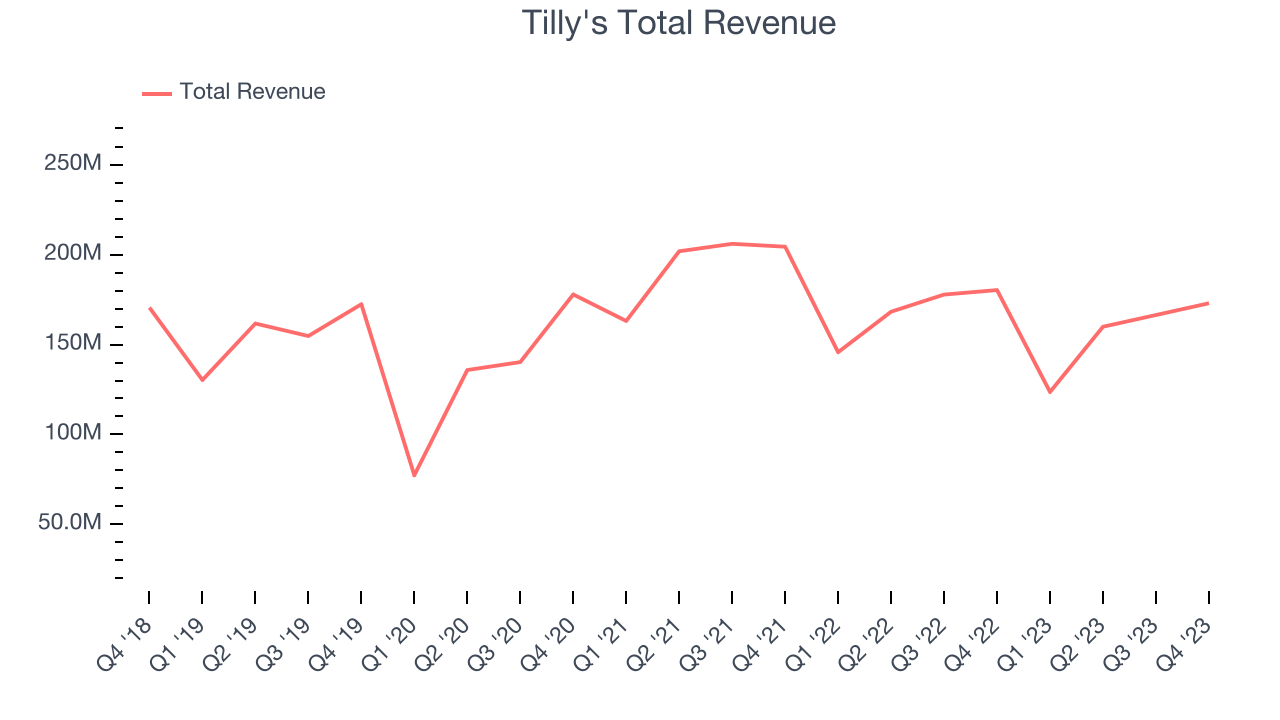
This quarter, Tilly's reported a rather uninspiring 4.1% year-on-year revenue decline to $173 million in revenue, in line with Wall Street's estimates. The company is guiding for a 7.8% year-on-year revenue decline next quarter to $114 million, an improvement from the 15.2% year-on-year decrease it recorded in the same quarter last year. Looking ahead, Wall Street expects revenue to remain flat over the next 12 months.
Number of Stores
The number of stores a retailer operates is a major determinant of how much it can sell, and its growth is a critical driver of how quickly company-level sales can grow.
When a retailer like Tilly's keeps its store footprint steady, it usually means that demand is stable and it's focused on improving operational efficiency to increase profitability. As of the most recently reported quarter, Tilly's operated 248 total retail locations, in line with its store count a year ago.
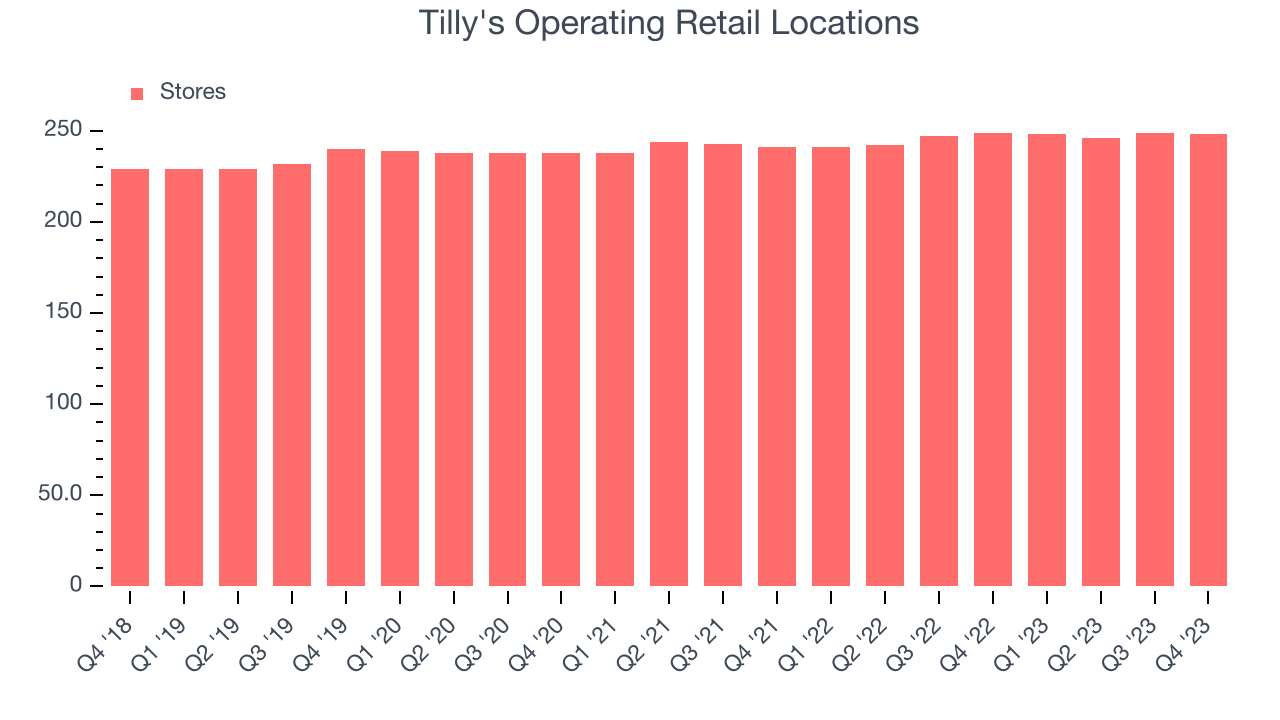
Over the last two years, the company has only opened a few new stores, averaging 1.3% annual growth in new locations. This sluggish pace lags the broader sector. A flat store base means that revenue growth must come from increased e-commerce sales or higher foot traffic and sales per customer at existing stores.
Same-Store Sales
A company's same-store sales growth shows the year-on-year change in sales for its brick-and-mortar stores that have been open for at least a year, give or take, and e-commerce platform. This is a key performance indicator for retailers because it measures organic growth and demand.
Tilly's demand has been shrinking over the last eight quarters, and on average, its same-store sales have declined by 12.7% year on year. This performance is quite concerning and the company should reconsider its strategy before investing its precious capital into new store buildouts.
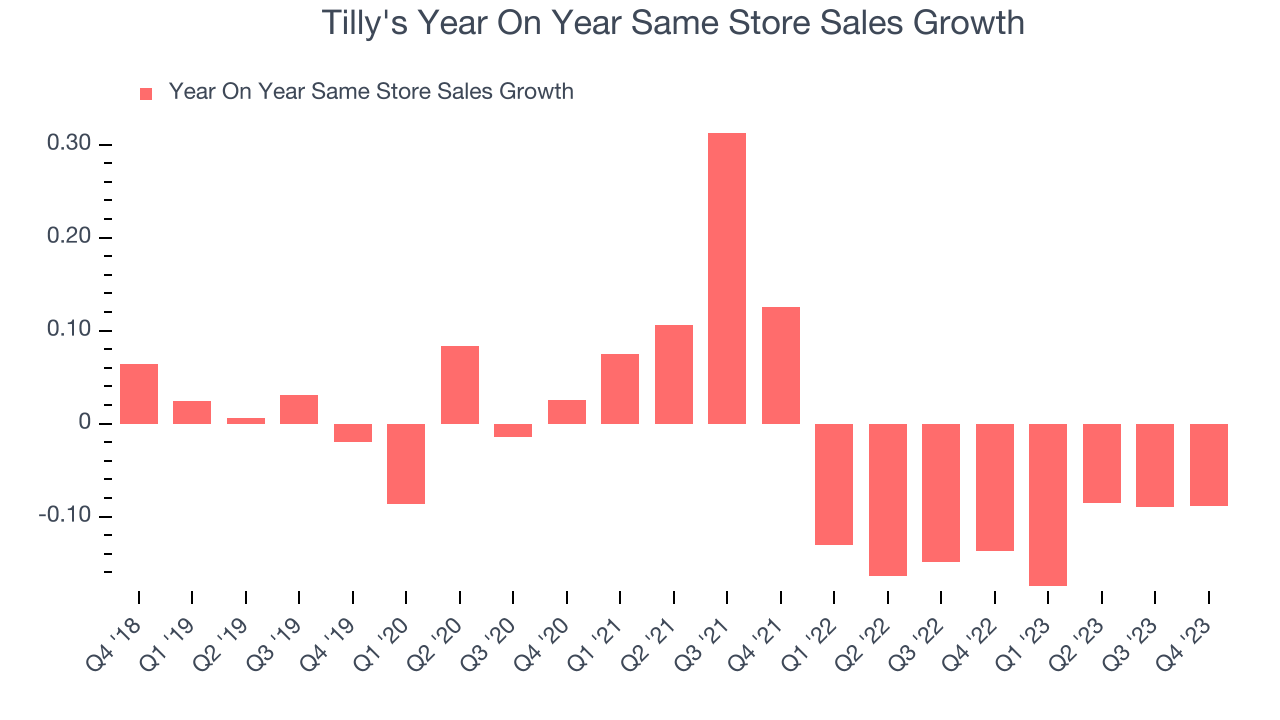
In the latest quarter, Tilly's same-store sales fell 8.8% year on year. This decrease was a further deceleration from the 13.7% year-on-year decline it posted 12 months ago. We hope the business can get back on track.
Gross Margin & Pricing Power
Tilly's has good unit economics for a retailer, giving it the opportunity to invest in areas such as marketing and talent to stay competitive. As you can see below, it's averaged a healthy 39.9% gross margin over the last two years. This means the company makes $0.40 for every $1 in revenue before accounting for its operating expenses.
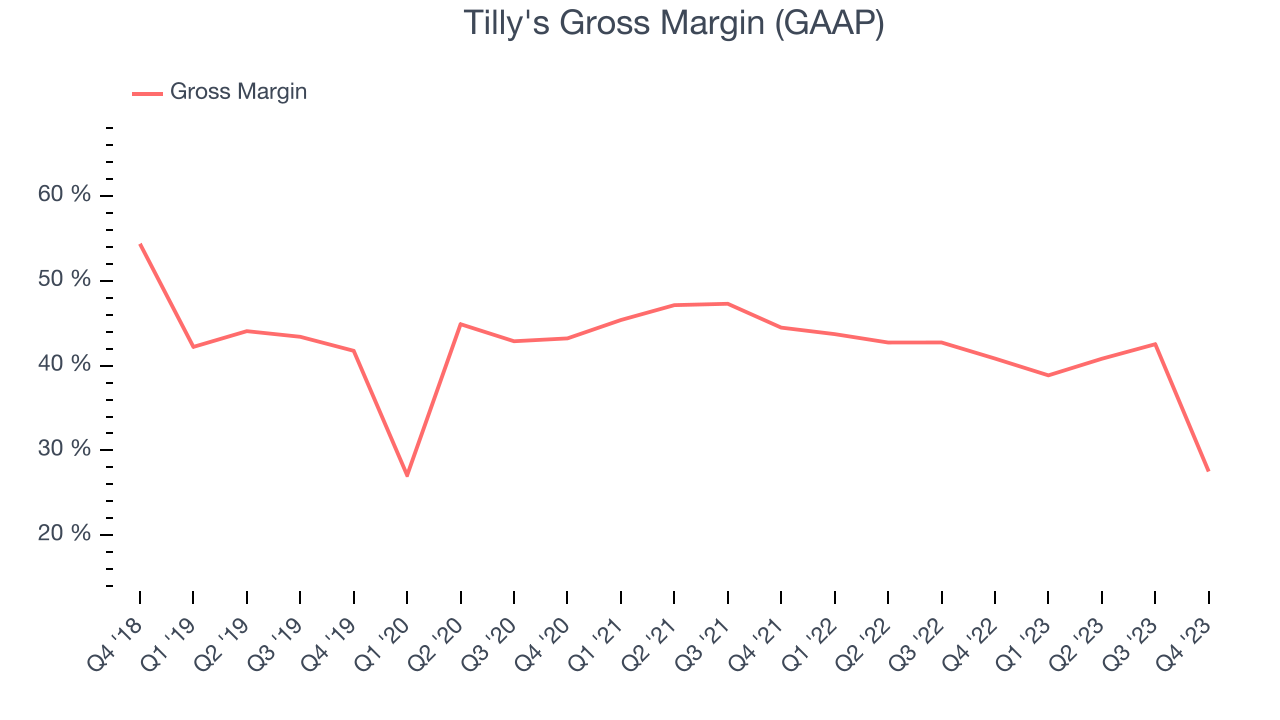
Tilly's gross profit margin came in at 27.5% this quarter, marking a 13.3 percentage point decrease from 40.8% in the same quarter last year. Although the company could've performed better, we care more about its long-term trends rather than just one quarter. Additionally, a retailer's gross margin can often change due to factors outside its control, such as product discounting and dynamic input costs (think distribution and freight expenses to move goods). We'll keep a close eye on this.
Operating Margin
Operating margin is an important measure of profitability for retailers as it accounts for all expenses keeping the lights on, including wages, rent, advertising, and other administrative costs.
In Q4, Tilly's generated an operating profit margin of negative 4.9%, down 4.2 percentage points year on year. This reduction was driven by weaker pricing power, as indicated by the company's larger drop in gross margin.
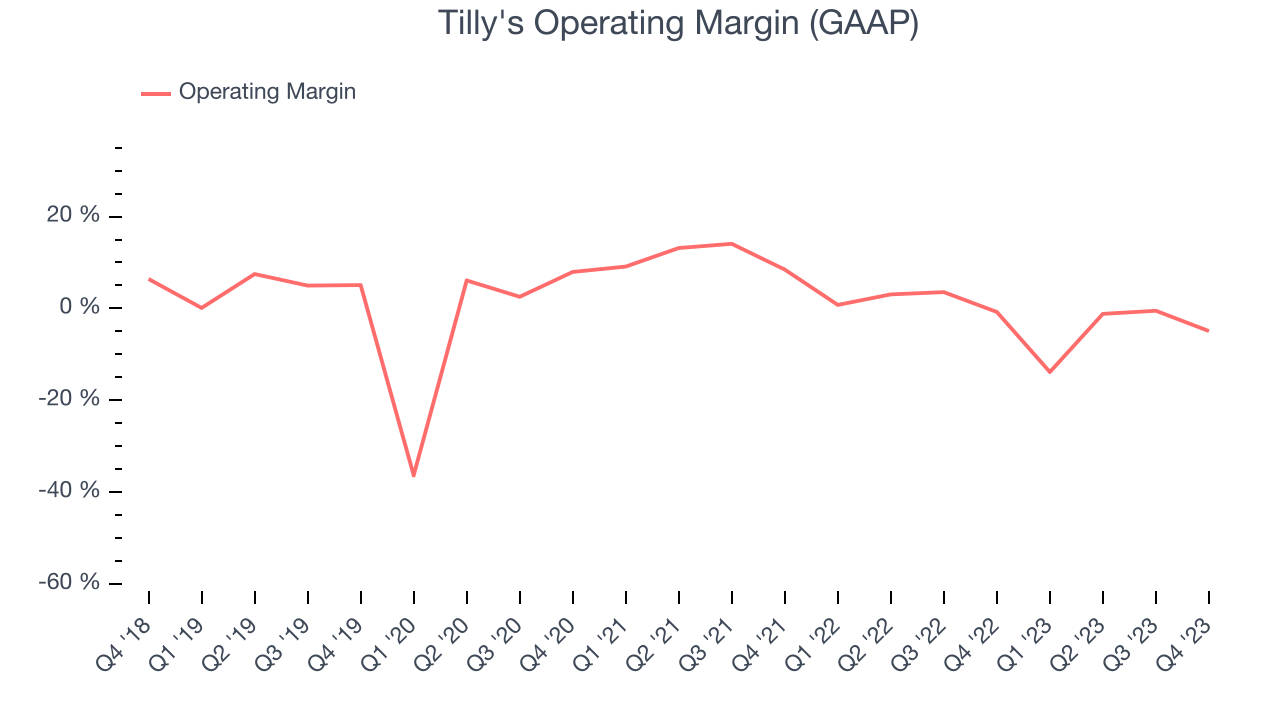 Unprofitable publicly traded companies are few and far between in the consumer retail sector, and over the last two years, Tilly's has been one of them. Its high expenses have contributed to an average operating margin of negative 1.3%. On top of that, Tilly's margin has declined, on average, by 6.2 percentage points year on year. This shows the company is heading in the wrong direction, and investors were likely hoping for better results.
Unprofitable publicly traded companies are few and far between in the consumer retail sector, and over the last two years, Tilly's has been one of them. Its high expenses have contributed to an average operating margin of negative 1.3%. On top of that, Tilly's margin has declined, on average, by 6.2 percentage points year on year. This shows the company is heading in the wrong direction, and investors were likely hoping for better results.EPS
Earnings growth is a critical metric to track, but for long-term shareholders, earnings per share (EPS) is more telling because it accounts for dilution and share repurchases.
In Q4, Tilly's reported EPS at negative $0.69, down from negative $0 in the same quarter a year ago. This print unfortunately missed Wall Street's estimates, but we care more about long-term EPS growth rather than short-term movements.
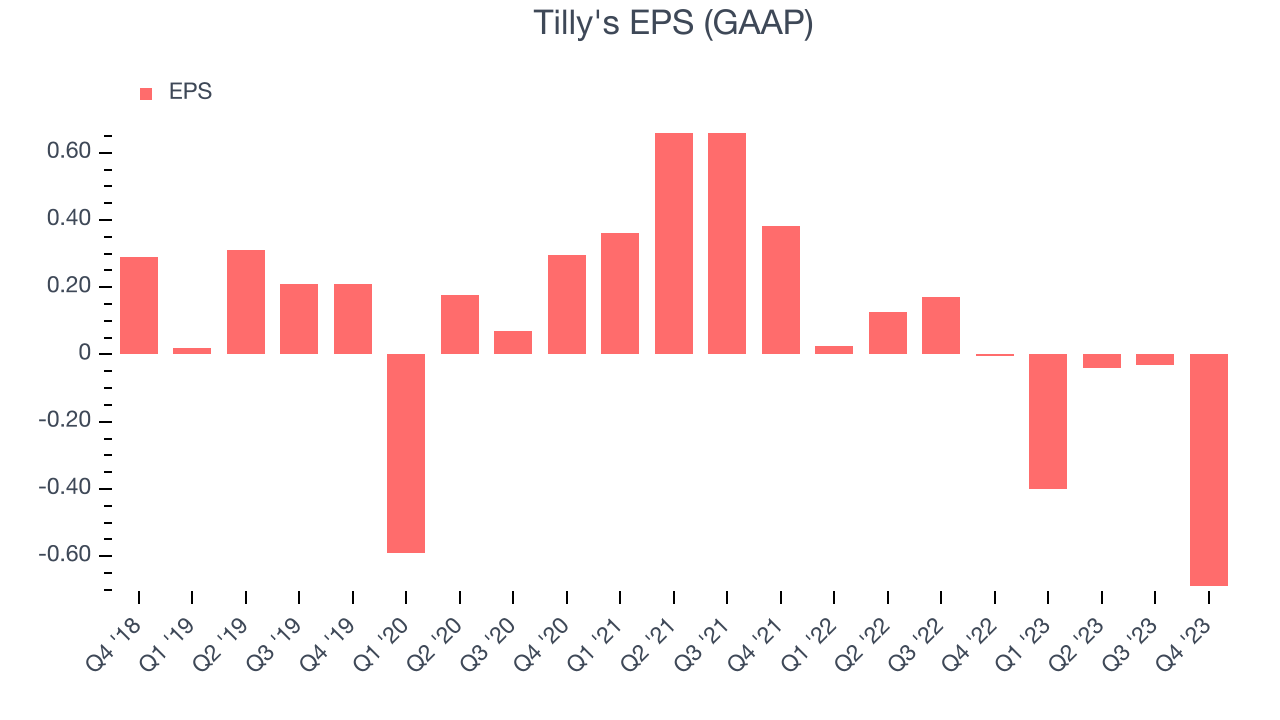
Between FY2019 and FY2023, Tilly's adjusted diluted EPS dropped 84.5%, translating into 37.3% annualized declines. In a mature sector such as consumer retail, we tend to steer our readers away from companies with falling EPS. If there's no earnings growth, it's difficult to build confidence in a business's underlying fundamentals, leaving a low margin of safety around the company's valuation (making the stock susceptible to large downward swings).
On the bright side, Wall Street expects the company's earnings to grow over the next 12 months, with analysts projecting an average 55.2% year-on-year increase in EPS.
Cash Is King
If you've followed StockStory for a while, you know that we emphasize free cash flow. Why, you ask? We believe in the end, cash is king, and you can't use accounting profits to pay the bills.
Tilly's broke even from a free cash flow perspective in Q4. The company's margin regressed this quarter as it was 3.4 percentage points lower than in the same period last year.
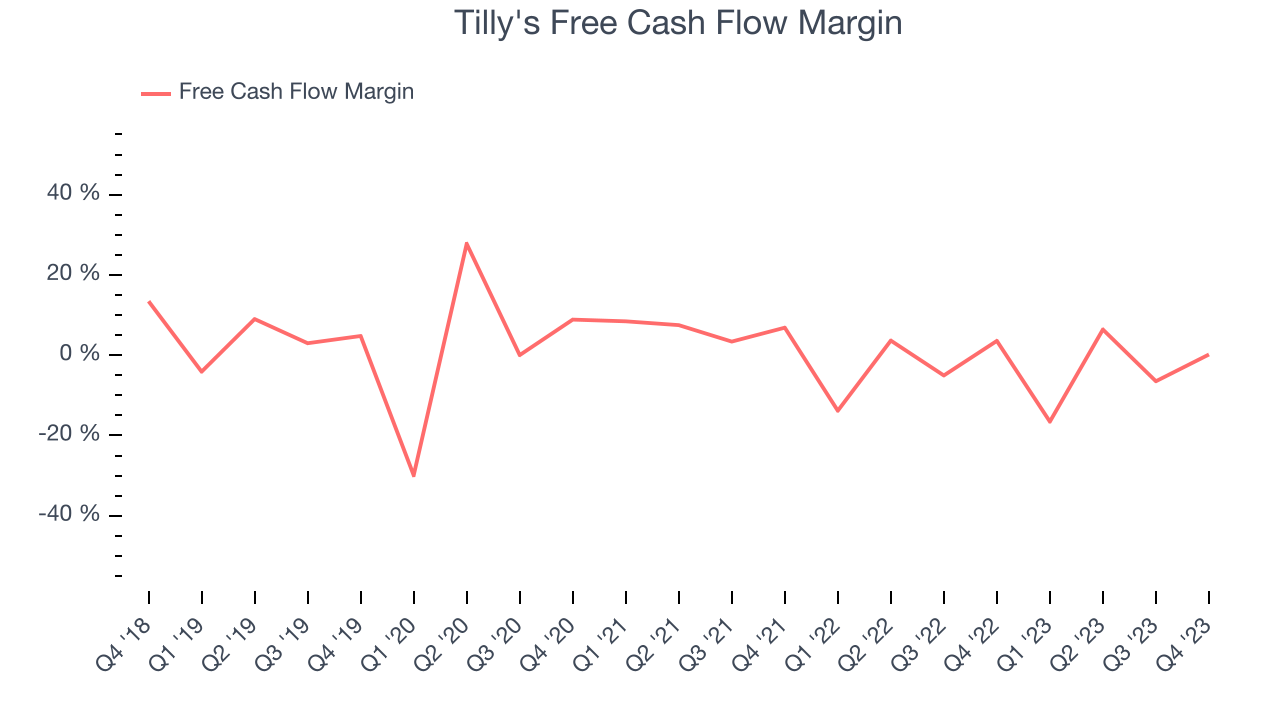
While Tilly's posted positive free cash flow this quarter, the broader story hasn't been so clean. Over the last eight quarters, Tilly's capital-intensive business model and demanding reinvestment strategy have consumed many company resources. Its free cash flow margin has averaged negative 2.9%, poor for a consumer retail business. Investors are likely hoping for consistent free cash flow generation in the future.
Return on Invested Capital (ROIC)
EPS and free cash flow tell us whether a company was profitable while growing revenue. But was it capital-efficient? A company’s ROIC explains this by showing how much operating profit a company makes compared to how much money the business raised (debt and equity).
Tilly's five-year average ROIC was 2.4%, somewhat low compared to the best retail companies that consistently pump out 25%+. Its returns suggest it historically did a subpar job investing in profitable business initiatives.
The trend in its ROIC, however, is often what surprises the market and drives the stock price. Unfortunately, Tilly's ROIC over the last two years averaged 10.9 percentage point decreases each year. In conjunction with its already low returns, these declines suggest the company's profitable business opportunities are few and far between.
Key Takeaways from Tilly's Q4 Results
We enjoyed seeing Tilly's exceed analysts' gross margin expectations this quarter. We were also happy its revenue narrowly outperformed Wall Street's estimates. On the other hand, its EPS fell significantly short, and its revenue and EPS guidance for next quarter missed analysts' expectations as its same-store sales have already declined 13.4% as of March 12, 2024. Overall, the results could have been better. The company is down 6.4% on the results and currently trades at $6.76 per share.
Is Now The Time?
Tilly's may have had a tough quarter, but investors should also consider its valuation and business qualities when assessing the investment opportunity.
We cheer for all companies serving consumers, but in the case of Tilly's, we'll be cheering from the sidelines. Its revenue growth has been weak over the last four years, but at least growth is expected to increase in the short term. And while its projected EPS for the next year implies the company's fundamentals will improve, the downside is its brand caters to a niche market. On top of that, its declining EPS over the last four years makes it hard to trust.
While we've no doubt one can find things to like about Tilly's, we think there are better opportunities elsewhere in the market. We don't see many reasons to get involved at the moment.
Wall Street analysts covering the company had a one-year price target of $8.63 per share right before these results (compared to the current share price of $6.76).
To get the best start with StockStory, check out our most recent stock picks, and then sign up to our earnings alerts by adding companies to your watchlist here. We typically have the quarterly earnings results analyzed within seconds of the data being released, and especially for companies reporting pre-market, this often gives investors the chance to react to the results before the market has fully absorbed the information.
